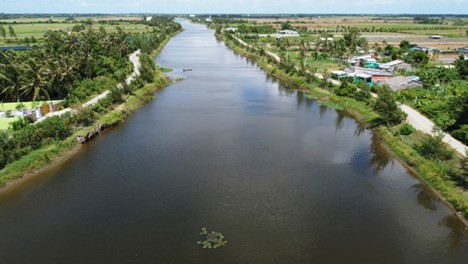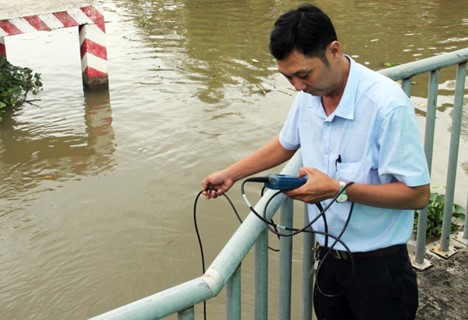Agricultures, News & Event
Western provinces cope with drought and salinity
Many western provinces actively flushed reservoirs early, built steel dams to temporarily store fresh water or planted seeds earlier to avoid drought and salinity.
These days, salt water has penetrated the fields in Ben Tre. Mr. Le Van Hao (70 years old, Phuoc Ngai commune, Ba Tri), a house near the Kenh Lap freshwater reservoir with a reserve of nearly one million m3, said that in previous years, the drought was severe, and there were times when the lake was dry. . Rain water stored in the cement tanks is also out, his family of 9 lacks fresh water, has to buy it for 60,000 VND per m3.
“This year, I actively build 8 more water storage reservoirs, totaling more than 10 m3, so I don’t have to worry about running out of water,” said Mr. Hao.

A representative of Kenh Lap reservoir management unit said that because the amount of salt still accumulated on the lake bottom, it has to be flushed every year to gradually reduce the salinity. Lessons learned from previous years, from October last year when the river water was still fresh, the lake was flushed to store water.
“Currently, the factory still takes treatment water from nearby infield canals, while the water in the lake has a salinity of 0.65 parts per thousand, which is guaranteed for domestic use and used for the peak of the drought season,” said a representative of the management unit. Li said.
Kenh Lap Lake has a total investment of 85 billion VND, has been used for 3 years, is nearly 5 km long, 40-100 m wide, 2 m deep, enough to serve about 200,000 people in 24 communes and towns in the area. . This is the largest artificial freshwater reservoir in the West.
According to the Ben Tre Center for Hydro-Meteorological Forecasting, from now to early March, saltwater intrusion may increase compared to previous weeks, but lower than the same period last year. On Ham Luong River, salinity of 1-4 parts per thousand (ppt) can penetrate to Chau Thanh district, 51-61 km from the river mouth. On Co Chien River, salinity of 1-4 parts per thousand can penetrate to Mo Cay Bac, Mo Cay Nam, 42-52 km from the river mouth.
In Tien Giang, Mr. Nguyen Duc Thinh, Deputy Director of the Sub-Department of Irrigation and Flood and Storm Control, Department of Agriculture and Rural Development, said that saltwater intrusion on the Tien River came earlier and went deeper into the field than in many years. before, but later, equal to and slightly higher than the previous year’s dry season. Salinity of 0.82 parts per thousand now reaches My Tho city.
The province is building a steel dam on Nguyen Tan Thanh canal, with a budget of more than 10 billion VND to prevent saltwater, store fresh water for 1.1 million people and 128,000 hectares of agricultural production. The dam is expected to be completed in the next few days. In addition, the province has 17 drilled wells and 100 public water faucets to serve people if the saline situation is complicated.
In Soc Trang, Mr. Phan Tan Dao, Head of Irrigation Sub-Department, said that the locality is currently at the peak of drought and salinity. At the culverts in Tran De district, near the East Sea, the salinity is more than 16 parts per thousand. On the Hau River in Ke Sach district, (about 40 km from the sea mouth) the salinity is also more than 1 part per thousand. Because the agricultural sector actively plans production, so far, no damage has been recorded.
More than 40,000 hectares of rice and cash crops in Long Phu district are recommended to sow a month earlier. This whole area has been harvested right before and after Tet. There are more than 40,000 hectares of fruit orchards in Ke Sach district, the local government strengthens dikes, culverts, stores fresh water, regularly monitors and reports the situation of drought and salinity daily to regulate water. By this time, people have almost finished harvesting, basically the garden is safe.

Meanwhile, Bac Lieu spent nearly VND 19 billion to build 537 temporary dams to prevent salinity to protect the rice crop on shrimp farming land and winter-spring rice cultivation in fresh areas. In addition, the properly operated Ninh Quoi boat lock culvert in Hong Dan district has actively regulated water, controlled salinity, and kept fresh for hundreds of thousands of hectares of rice and vegetables in Bac Lieu, Soc Trang and Hau Giang. .
In Hau Giang, some localities in Chau Thanh, Long My and Vi Thanh districts recorded salinity from 0.1 to 7.2 parts per thousand. The People’s Committee of Hau Giang province requested localities to take measures to limit damage caused by drought and saltwater intrusion. Especially, actively review and effectively operate the system of dikes and sluice gates to prevent saltwater intrusion in order to protect the Winter-Spring rice crop.
Mr. Le Hong Linh, Head of Irrigation Construction and Investment Management Board 10 (Ministry of Agriculture and Rural Development), said that currently all valve gates of Cai Lon and Cai Be sluice gates (the largest in the West, investment capital of VND 3,300 billion) in Chau Thanh district, Kien Giang province, sealed to prevent salt water from entering, keeping fresh for production for hundreds of thousands of hectares of land in Kien Giang, Hau Giang, Ca Mau and Bac Lieu .
Source: https://vnexpress.net/cac-tinh-mien-tay-ung-pho-han-man-4430751.html
